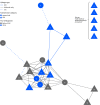Outbreak of Human Immunodeficiency Virus Infection Among Heterosexual Persons Who Are Living Homeless and Inject Drugs - Seattle, Washington, 2018
- PMID: 30998671
- PMCID: PMC6476056
- DOI: 10.15585/mmwr.mm6815a2
Outbreak of Human Immunodeficiency Virus Infection Among Heterosexual Persons Who Are Living Homeless and Inject Drugs - Seattle, Washington, 2018
Abstract
Although diagnoses of human immunodeficiency virus (HIV) infection among persons who inject drugs in the United States are declining, an HIV outbreak among such persons in rural Indiana demonstrated that population's vulnerability to HIV infection (1). In August 2018, Public Health-Seattle and King County (PHSKC) identified a cluster of cases of HIV infection among persons living homeless, most of whom injected drugs. Investigation identified 14 related cases diagnosed from February to mid-November 2018 among women who inject drugs and men who have sex with women (MSW) who inject drugs and their sex partners. All 14 persons were living homeless in an approximately 3-square-mile area and were part of a cluster of 23 cases diagnosed since 2008. Twenty-seven cases of HIV infection were diagnosed among women and MSW who inject drugs in King County during January 1-November 15, 2018, a 286% increase over the seven cases diagnosed in 2017. PHSKC has alerted medical and social service providers and the public about the outbreak, expanded HIV testing among persons who inject drugs or who are living homeless, and is working to increase the availability of clinical and prevention services in the geographic area of the outbreak. This outbreak highlights the vulnerability of persons who inject drugs, particularly those who also are living homeless, to outbreaks of HIV infection, even in areas with high levels of viral suppression and large syringe services programs (SSPs).
Conflict of interest statement
All authors have completed and submitted the ICMJE form for disclosure of potential conflicts of interest. Matthew R. Golden reports grants from GSK and Hologic, outside the submitted work. Julie Dombrowski reports grants from Hologic, Curatek, and Quidel to the University of Washington and personal fees from PRIME and the MidAtlantic AIDS Education and Training Center, outside the submitted work. No other potential conflicts of interest were disclosed.
Figures

References
-
- Public Health–Seattle & King County; Washington State Department of Health. HIV/AIDS epidemiology report King County & Washington State 2018. Seattle, Washington: Public Health–Seattle & King County, Washington State Department of Health; 2018. https://www.kingcounty.gov/depts/health/communicable-diseases/hiv-std/pa...

